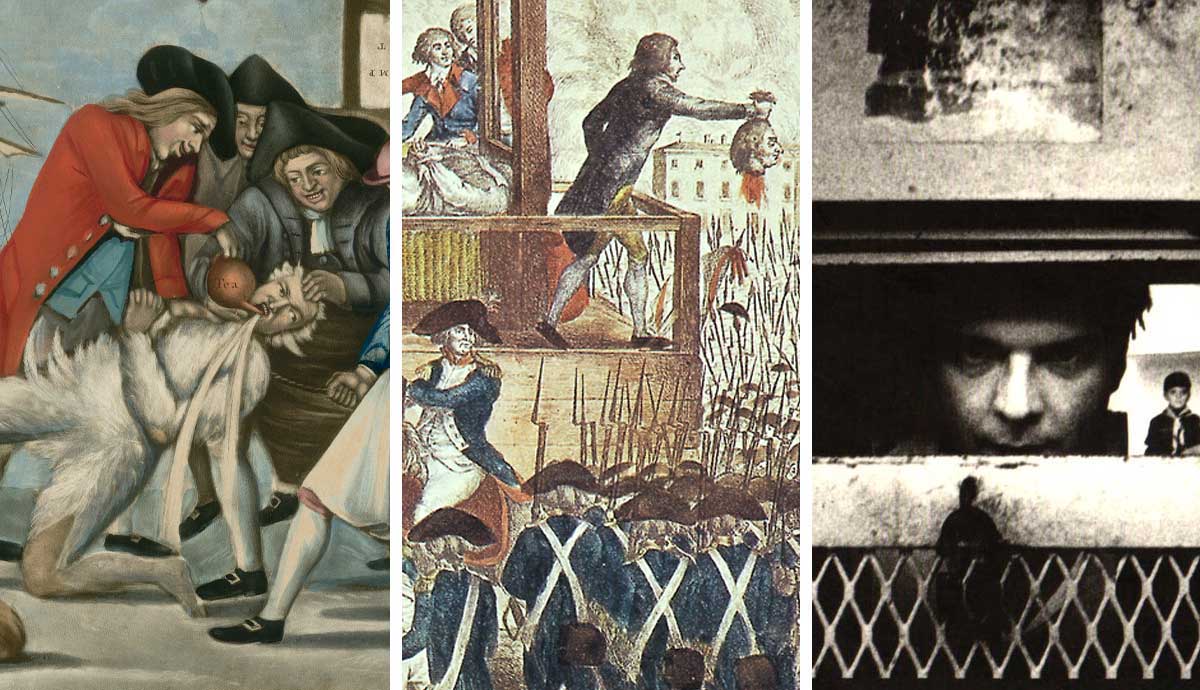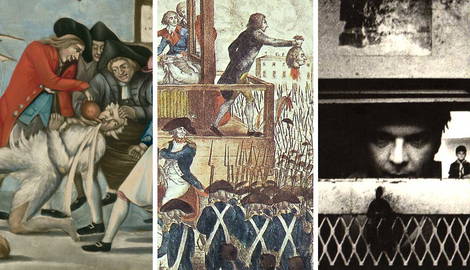
Michel Foucault’s book Discipline and Punish sets up to embark on a major historical enquiry. Foucault aimed to investigate the emergence of prisons as the symbol of our modern form of punishment. To do this, he studied the development and transformation of what could be called the “barbaric punishment” into the “calculated punishment” we have today. Foucault challenges the standard story proposed by the humanists and positivists, who saw the development of punishment as an effect brought about by the enlightenment, science and the increased value we put on reason.
The Beginning of Discipline and Punish: The Execution of Damiens

Discipline and Punish opens up with a horrific description, the execution of Robert-François Damiens, which took place on the second of march, 1757. The details of the execution and the torture it included will make your stomach turn. After getting burned with wax and Sulphur, horses were harnessed to his arms and legs, and they were made to run in different directions so that Damiens would be dismembered. Four horses were used at the beginning, but that didn’t work, so they added two more.
This did not suffice either. The limbs were still largely intact. The executioners then started to cut off Damiens’ tendons. This also proved difficult. As Foucault himself describes:
“Though a strong, sturdy fellow, this executioner found it so difficult to tear away the pieces of flesh that he set about the same spot two or three times, twisting the pincers as he did so, and what he took away formed at each part a wound about the size of a six-pound crown piece.”
Finally, the limbs gave in and Damiens was dismembered. Spectators watched this botched execution in shock and Damiens’ last agonizing screams left a mark in everyone who was present.
The Shift in Execution

In our modern times, this execution would strike us as incredibly barbaric. Indeed, there have been major changes in the ways punishment is delivered to those found guilty. The shift from the barbaric and impulsive execution to the calculated, cold and rational punishments we have today is often praised as human progress by many.
In Discipline and Punish, Foucault has drawn up a different thesis, one which doesn’t see the shift as a cause of increased rationality or enlightenment but as a sophistication of power. In short, the spectacle of punishment has diminished not because it came into conflict with humanistic concepts but because it wasn’t efficient anymore. By the end of the eighteenth century, the art of public execution and torture as a spectacle was dying out.
Think about Damiens’ execution. The first thing we’ll notice is that it was held in public, and a lot of people gathered to see it. Modern day executions, on the contrary, are hidden away and conducted privately in isolated jails, far from the eyes of the public. This shift away from the public is done for quite a few reasons. For example, Foucault notes in Discipline and Punish that in many executions, people would start sympathizing with the condemned. Angry crowds might form and there was always a risk that they would start questioning the power of the king.
The King: Power Put into Question

The barbaric execution demonstrates the asymmetrical relation between the king and the criminal, the power imbalance between the sovereign and those who dare question him. A crime wasn’t simply the violation of a societal law but was a violation of the will of the king to impose said laws. Any offence was read as a direct challenge to the king, and failure to respond accordingly put the king in a predicament. Despite the efficiency of the barbaric execution, another problem was that it could go horribly wrong.
In the Damiens example, we can see how much struggle was involved in killing one man. The crowd might start to question the will of the king when they see that things aren’t going according to his will.
Bureaucratic Disavowal: Redistributing Responsibility

Another major change was the redistribution of guilt. In the case of barbaric punishment, it was clear that the king was striking down because someone dared to question his will. On the other hand, in the case of rational punishment, the penal logic which perpetuates punishment appears to be disinterested and takes no pleasure in serving the punishment. It appears as if the penal system is ashamed of itself for having to deliver the sentence, but it is left with no choice.
“As a result, justice no longer takes public responsibility for the violence that is bound up with its practice. If it too strikes, if it too kills, it is not as a glorification of its strength, but as an element of itself that it is obliged to tolerate, that it finds difficult to account for.”
This new and impersonal form of punishment is founded on a system of bureaucratic disavowal. Punishment is presented here almost as Newton’s third law, as a neutral object X (the penal system) which is simply reflecting back the force exerted on it by object Y (the criminal).
Who is to Blame for the Punishment?

Through this bureaucratization, the responsibility for delivering the punishment, which was previously concentrated on the Monarch, disappears through the impersonal relations that constitute modern penal jurisprudence. If you previously would have thought that the king shouldn’t have punished someone with death, you might start objecting and resenting the king. Now, who will you resent? An abstract system of laws which is so impersonal that it almost feels like being against it would be like being against gravity or any natural law? The same act of injustice becomes much more difficult to articulate, and any eventual anger stands directionless.
If there is any pain experienced during a punishment it is not the goal of the rational penal system but just an unfortunate consequence. Indeed, Foucault notes in Discipline and Punish how even in penitentiaries where criminals are on death row there’s a doctor which follows the health and wellbeing of the condemned carefully up until their final moment. A weightless, painless death which lasts only a fraction of a minute, delivered by an impartial, nameless and disinterested party.
The collapse of the way in which gruesome death punishments could be delivered marks the emergence of a new moral axis concerned with the act of punishing. We also see here the introduction of black veils that would cover the face of the condemned. No-one would see them before being executed. Punishment would remain a secret pact between the condemned and the system condemning it. Even witnesses who described scenes of capital punishment to others could be legally persecuted.
From Body to Soul, from Personal to Impersonal

There’s another important difference between the barbaric and rational execution. The barbaric execution is often personal. The punishment is made to reflect the crime. For example, if you steal something, your hand might be cut off so that you can no longer steal. On the contrary, rational execution is nonspecific, non-personal, universal, generalized. It has the same response no matter the crime and its circumstances. It is cold and impersonal. Punishment didn’t simply change in execution but in its entirety.
This is demonstrated in the fact that modern punishment started targeting the mind instead of the body. There was a change in objective, in the target that punishment was aiming for, literally and figuratively. Even in the switch from the body to the mind, Foucault maintains that bodily pain was always included to some degree. Think of the modern prison where a lot of the time there’s little to no concern about fights that break out between prisoners in which they might end up getting killed, about the violence that the guards might inflict on prisoners, about those killed or injured during interrogation sessions or even the mere existence of solitary confinement.
Some degree of corporal pain is always included but it was no longer the focal point of punishment. Its strike was directed elsewhere: into the very soul of the condemned. If in the previous forms of punishment, the focus was on the crime itself, now it could no longer be found there. It relocated into the soul of the person that was doing the crime. What became important was what the crime says about the person committing it, not just the crime itself as such.
Discipline and Punish: A Challenge to the Standard Narrative of Progress

The switch from one form of punishment to the other, from spectacle to concealment, from brutality to calculation, did not happen at a single stroke across all countries. It was a lengthy process with a lot of delays and some places saw an occasional upsurge in barbaric punishments. However, there was nevertheless an undeniable tendency towards the abolishment of torture and brutal executions.
By the 1840s in most places in Europe, the punishment spectacle had died out and its full replacement with the new methods of punishment was taking over. This transformation marked a new and more efficient method for power structures to control their subjects, a more silent and invisible force which penetrated everywhere. The efficiency of this method is most clearly demonstrated by the fact that it still stands today as an unchallenged and universal power.
We as human beings really like stories. We like narratives that seem to go somewhere, that have a point. There hasn’t been a single story which has had a larger impact than the story of the progress made by enlightenment, rationality and human values. When we look at the facts of history, we see something else. There’s no linear simple story where all events follow each other neatly through cause and effect. We see a mess of causes all in conflict with one another competing for their place in a narrative.
The evolution of punishment did not come about simply because of an awakening of human values. Its practice was transformed and adapted to the material conditions which called for more effective ways of control, better ways of punishing and disciplining the subject. The story of progress of human values is simply the story of the evolution of power, which permeates the subject and becomes ever-more sophisticated.










